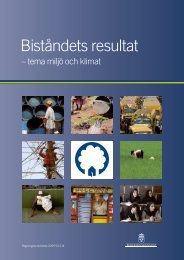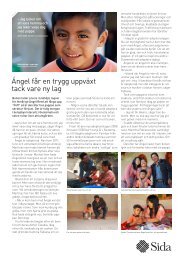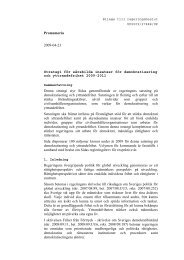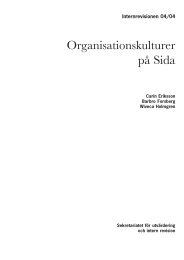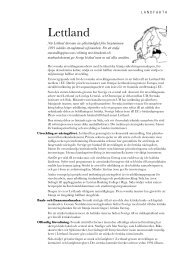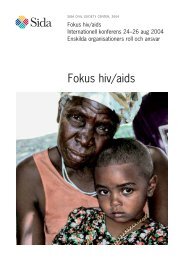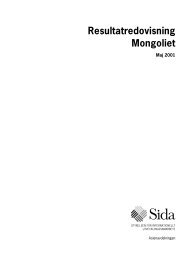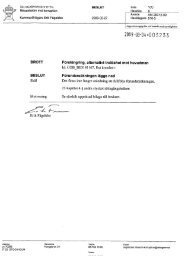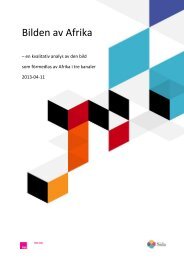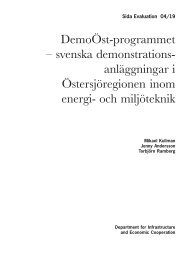Mid-Term Review of the AGIR Programme - Sida
Mid-Term Review of the AGIR Programme - Sida
Mid-Term Review of the AGIR Programme - Sida
You also want an ePaper? Increase the reach of your titles
YUMPU automatically turns print PDFs into web optimized ePapers that Google loves.
2 F I N D I N G S<br />
no policy at all. According to <strong>the</strong> same source, few Oxfam partners have gender and<br />
HIV/AIDS policies in place. However, this can be misleading as most <strong>of</strong> <strong>the</strong>m have<br />
activities in <strong>the</strong>se areas. 7 <strong>of</strong> 11 <strong>of</strong> Diakonia’s partners have activities in <strong>the</strong>se areas,<br />
but do not have policies or written instruments with activities in <strong>the</strong>se areas having<br />
been done in an ad-hoc way. All four SCC partners, by <strong>the</strong> end <strong>of</strong> 2011, had gender<br />
and HIV/AIDS activities noted in <strong>the</strong>ir strategic plans or programmes, but still needed<br />
to operationalise <strong>the</strong>se plans through policies and implementation structures and processes.<br />
Overall, gender and HIV/AIDS-based monitoring remain weak. The 4 <strong>AGIR</strong> intermediaries<br />
have recognised this weakness and have applied some <strong>of</strong> <strong>the</strong>ir first capacity<br />
streng<strong>the</strong>ning efforts to this area through <strong>the</strong> testing, in 2012, <strong>of</strong> a new changeoriented<br />
gender training approach which has produced good results. The intermediaries<br />
have agreed to use this training method within 2012 and funds are available. It is<br />
expected that this should greatly improve <strong>the</strong> documentation <strong>of</strong> results through <strong>the</strong><br />
use <strong>of</strong> cross-cutting gender indicators in 2013 (this is stated with <strong>the</strong> caveat that partners<br />
would need to improve <strong>the</strong>ir reporting <strong>of</strong> results and intermediaries would need<br />
to better systematise and improve <strong>the</strong>ir reporting in <strong>the</strong> joint results matrix so that<br />
results, not only in gender, are clearly related to indicators).<br />
With respect to specific <strong>the</strong>matic gender outcomes, variable positive progress is noted.<br />
For example:<br />
Advocacy efforts by AMCS (Women in Social Communication Association)<br />
were directed at <strong>the</strong> ‘The National Media Council’ for a bylaw to ensure gender<br />
balance in public TV and Radio broadcast contents. This pressure received<br />
a positive response from <strong>the</strong> council. Not only did this contribute to <strong>the</strong><br />
achievement <strong>of</strong> outcomes associated with gender violation cases exposed by<br />
<strong>the</strong> media, but also had a direct impact on media houses in ensuring <strong>the</strong> employment<br />
<strong>of</strong> more women and journalists (both men and women) and increasing<br />
<strong>the</strong>ir coverage <strong>of</strong> gender sensitive issues.<br />
Gender mainstreamed practices are strong in land and natural resources. Local<br />
partners, for example AAAJC and UPCT (Tete Provincial Farmers Union),<br />
have conducted gender sensitive interventions on information and awareness<br />
development activities at <strong>the</strong> community level. These activities have included<br />
debates on <strong>the</strong> role <strong>of</strong> women in rural development, <strong>the</strong> role <strong>of</strong> gender in legislation/policies<br />
on mining, and land rights for men and women. 29 A preliminary<br />
<strong>AGIR</strong> programme result monitoring exercise by AAAJC reflects gender<br />
(not HIV/AIDS), but does not yet manage to specify gender specific programme<br />
indicators, which are expected to be included in <strong>the</strong> annual monitoring<br />
report by <strong>the</strong> end <strong>of</strong> 2012.<br />
29 These activities are outcomes in <strong>AGIR</strong>’s results matrix on ”citizens’, particularly women’s, land rights”,<br />
and ”access to natural resources are protected in policies, legislation and regulations”.<br />
62




